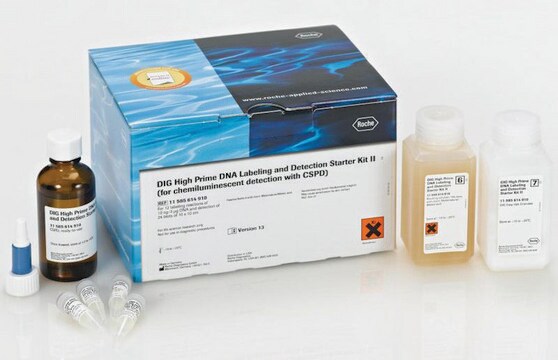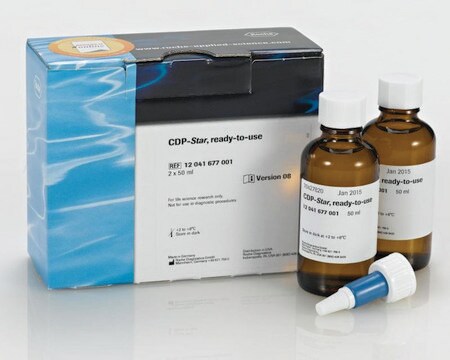Key Documents
12039672910
Roche
DIG Northern Starter Kit
suitable for Northern blotting, sufficient for 10 labeling reactions
Synonim(y):
DIG system, Northern blot
About This Item
Polecane produkty
zastosowanie
sufficient for 10 blots (blots of 10 x 10 cm2)
sufficient for 10 labeling reactions
Poziom jakości
producent / nazwa handlowa
Roche
charakterystyka ekologicznej alternatywy
Designing Safer Chemicals
Learn more about the Principles of Green Chemistry.
sustainability
Greener Alternative Product
Parametry
68 °C optimum reaction temp.
metody
Northern blotting: suitable
kategoria ekologicznej alternatywy
temp. przechowywania
−20°C
Opis ogólny
Zastosowanie
Opakowanie
1 kit for up to 10 labeling reactions and detection of 10 blots, blots of 10×10cm2, reactions of μg DNA, yielding approx. 20μg labeled RNA, each
Uwaga dotycząca przygotowania
Assay Time: 9 hours 30 minutes
Sample Materials:
- Linearized plasmid, including the appropriate RNA polymerase promoter sequence (SP6, T3, T7).
- Specially prepared PCR productWorking solution: Note: Use sterile, RNase-free solutions and equipment.
Note: The length of the region to be transcribed should be in the range of 200 to 1,000 bp. To avoid RNase contamination the DNA must be phenolized.
Inne uwagi
Tylko elementy zestawu
- Labeling Mix 5x concentrated
- Transcription Buffer 5x concentrated
- SP6 RNA Polymerase 20 U/μl
- T7 RNA Polymerase 20 U/μl
- T3 RNA Polymerase 20 U/μl
- Anti-Digoxigenin-AP antibody, Fab fragments 750 U/ml
- DNase I, RNase free 10 U/μl
- CDP-Star ready-to-use
- Actin RNA Probe, DIG-labeled Antisense Probe, length 588 bases 10 ng/μl
- DIG Easy Hyb Granules
- Blocking Solution 10x concentrated
Hasło ostrzegawcze
Danger
Zwroty wskazujące rodzaj zagrożenia
Zwroty wskazujące środki ostrożności
Kod klasy składowania
12 - Non Combustible Liquids
Klasa zagrożenia wodnego (WGK)
WGK 3
Temperatura zapłonu (°F)
does not flash
Temperatura zapłonu (°C)
does not flash
Certyfikaty analizy (CoA)
Poszukaj Certyfikaty analizy (CoA), wpisując numer partii/serii produktów. Numery serii i partii można znaleźć na etykiecie produktu po słowach „seria” lub „partia”.
Masz już ten produkt?
Dokumenty związane z niedawno zakupionymi produktami zostały zamieszczone w Bibliotece dokumentów.
Klienci oglądali również te produkty
Produkty
Digoxigenin (DIG) labeling methods and kits for DNA and RNA DIG probes, random primed DNA labeling, nick translation labeling, 5’ and 3’ oligonucleotide end-labeling.
Metody znakowania digoksygeniną (DIG) i zestawy do sond DNA i RNA DIG, znakowanie DNA z losowym primerem, znakowanie nickiem translacyjnym, znakowanie końcowe oligonukleotydów 5' i 3'.
Protokoły
DIG Northern Starter Kit Protocol & Troubleshooting
Nasz zespół naukowców ma doświadczenie we wszystkich obszarach badań, w tym w naukach przyrodniczych, materiałoznawstwie, syntezie chemicznej, chromatografii, analityce i wielu innych dziedzinach.
Skontaktuj się z zespołem ds. pomocy technicznej








